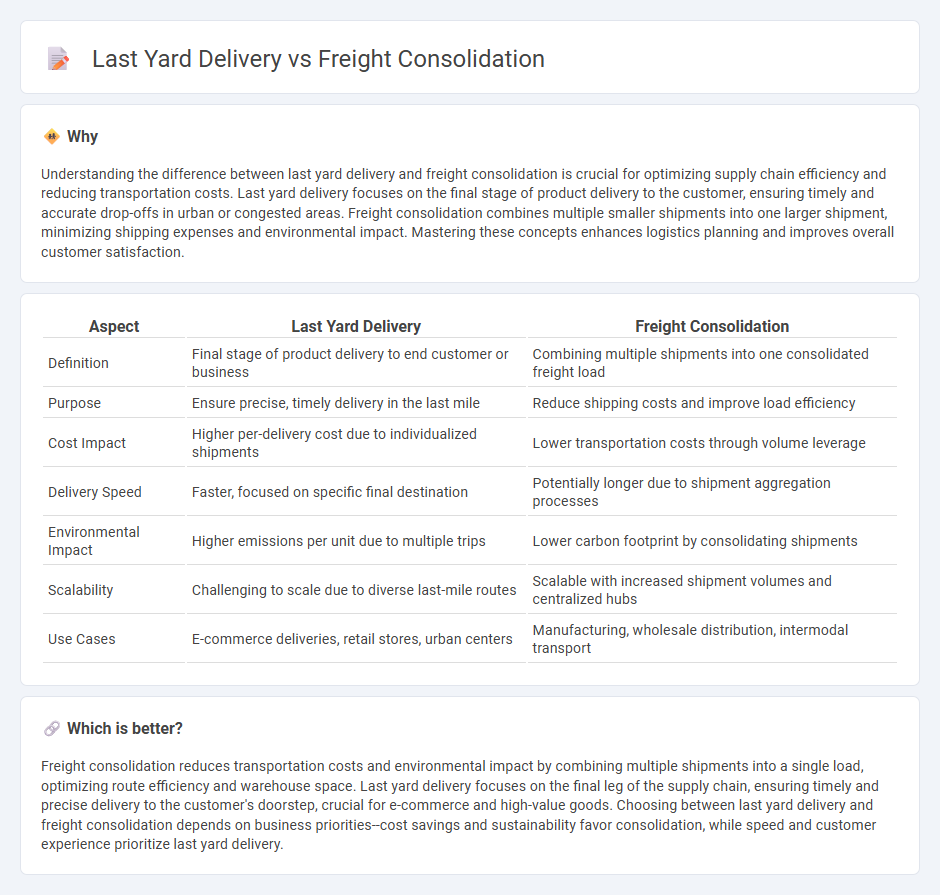
Last yard delivery focuses on efficiently managing the final stage of the logistics chain by ensuring timely and accurate shipment to end customers, often dealing with urban challenges and small parcel complexities. Freight consolidation optimizes transportation by combining multiple smaller shipments into a single load, reducing costs, improving fuel efficiency, and minimizing carbon emissions across long-haul routes. Explore the advantages and strategic applications of last yard delivery versus freight consolidation to enhance your supply chain performance.
Why it is important
Understanding the difference between last yard delivery and freight consolidation is crucial for optimizing supply chain efficiency and reducing transportation costs. Last yard delivery focuses on the final stage of product delivery to the customer, ensuring timely and accurate drop-offs in urban or congested areas. Freight consolidation combines multiple smaller shipments into one larger shipment, minimizing shipping expenses and environmental impact. Mastering these concepts enhances logistics planning and improves overall customer satisfaction.
Comparison Table
| Aspect | Last Yard Delivery | Freight Consolidation |
|---|---|---|
| Definition | Final stage of product delivery to end customer or business | Combining multiple shipments into one consolidated freight load |
| Purpose | Ensure precise, timely delivery in the last mile | Reduce shipping costs and improve load efficiency |
| Cost Impact | Higher per-delivery cost due to individualized shipments | Lower transportation costs through volume leverage |
| Delivery Speed | Faster, focused on specific final destination | Potentially longer due to shipment aggregation processes |
| Environmental Impact | Higher emissions per unit due to multiple trips | Lower carbon footprint by consolidating shipments |
| Scalability | Challenging to scale due to diverse last-mile routes | Scalable with increased shipment volumes and centralized hubs |
| Use Cases | E-commerce deliveries, retail stores, urban centers | Manufacturing, wholesale distribution, intermodal transport |
Which is better?
Freight consolidation reduces transportation costs and environmental impact by combining multiple shipments into a single load, optimizing route efficiency and warehouse space. Last yard delivery focuses on the final leg of the supply chain, ensuring timely and precise delivery to the customer's doorstep, crucial for e-commerce and high-value goods. Choosing between last yard delivery and freight consolidation depends on business priorities--cost savings and sustainability favor consolidation, while speed and customer experience prioritize last yard delivery.
Connection
Last yard delivery and freight consolidation enhance supply chain efficiency by reducing transportation costs and minimizing environmental impact. Freight consolidation combines shipments into fewer loads, enabling smoother last yard delivery to final destinations with fewer trips. Streamlining these processes optimizes logistics operations, improves delivery speed, and reduces overall carbon emissions.
Key Terms
Shipment Aggregation
Shipment aggregation in freight consolidation involves combining multiple smaller shipments into a single load to optimize transportation efficiency and reduce costs. In contrast, last yard delivery focuses on the final stage of shipping, where consolidated shipments are broken down for delivery to individual destinations. Explore the advantages of shipment aggregation and how it improves supply chain efficiency.
Cross-Docking
Freight consolidation combines multiple smaller shipments into one larger load to reduce transportation costs and improve efficiency, whereas last yard delivery focuses on the final stage of distribution, ensuring goods reach the end customer promptly. Cross-docking plays a critical role by enabling rapid transfer of consolidated freight directly from inbound to outbound transportation without storage, minimizing handling time and inventory costs. Explore how optimizing cross-docking strategies can enhance both freight consolidation and last yard delivery performance.
Final Mile Logistics
Freight consolidation in final mile logistics involves combining multiple shipments to optimize delivery routes, reducing transportation costs and environmental impact. Last yard delivery focuses on the crucial phase of dropping goods at the customer's doorstep, emphasizing speed, accuracy, and sustainability in urban areas. Explore in-depth insights on how these methods revolutionize final mile efficiency and customer satisfaction.
Source and External Links
Understanding Freight Consolidation - SupplierWiki - Freight consolidation is the process of combining multiple smaller shipments from different suppliers into one single shipment to reduce costs and improve shipping efficiency for domestic and international transport.
What is Freight Consolidation? Trinity Explains. - Freight consolidation involves merging multiple regional shipments into one load to achieve better rates and optimize logistics, especially beneficial for shippers with smaller or partially filled shipments.
Freight Consolidation: What It Is and When to use it. - Freight consolidation significantly cuts costs by allowing businesses to benefit from full truckload pricing on less-than-truckload shipments, also improving supply chain performance by reducing delays and handling complexity.
 dowidth.com
dowidth.com